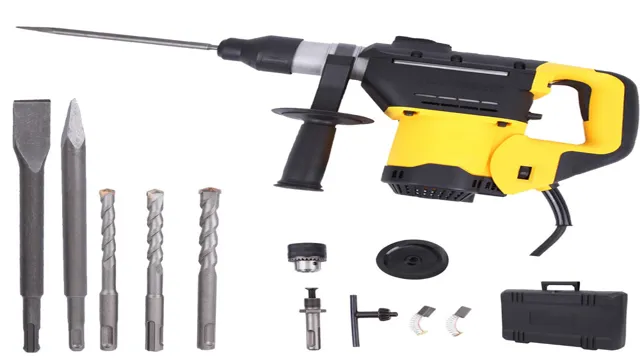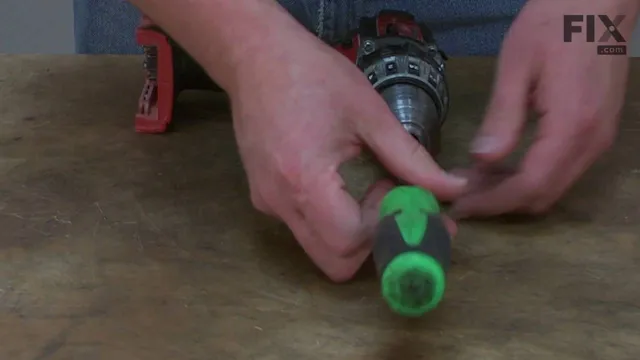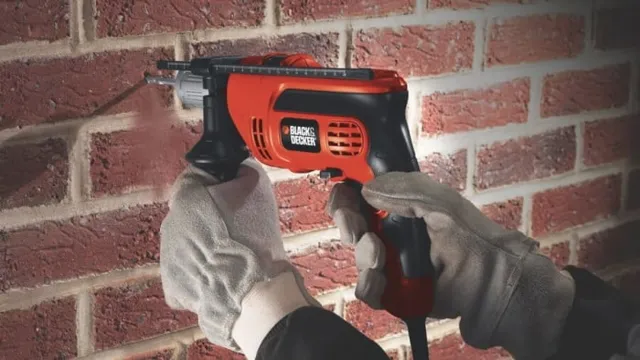Can You Use a Hammer Drill as an Impact Driver? The Ultimate Guide
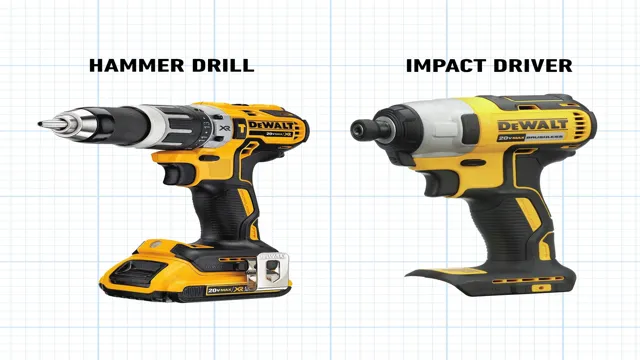
If you’re into woodworking and DIY projects, chances are you have a set of power tools in your arsenal, including a hammer drill and impact driver. Hammer drills are usually used for drilling through masonry and concrete, while impact drivers are great for fastening screws and nuts. But did you know that you can use a hammer drill as an impact driver too? While it may sound like a great idea to have a multi-functional tool in your workshop, there are pros and cons to consider before doing so.
In this blog, we’ll explore the advantages and disadvantages of using a hammer drill as an impact driver, as well as the factors you need to keep in mind when making the switch. Whether you’re a seasoned woodworker or a beginner, this article will give you the insights you need to make an informed decision and get the most out of your power tools. So, let’s dive in!
What is a Hammer Drill vs. an Impact Driver?
While a hammer drill and an impact driver may look similar, they serve different purposes. A hammer drill is designed to drill into tough materials such as concrete and masonry, while an impact driver is used for driving screws and bolts. However, in some cases, you can use a hammer drill as an impact driver by attaching a suitable hex driver bit to the chuck.
This can be useful when you have limited tools on hand or need to perform both drilling and driving in the same project. Keep in mind that while a hammer drill may be able to drive screws and bolts, it may not be as efficient or gentle as an impact driver, which can provide more control and precision when working with smaller screws or delicate materials. Ultimately, whether or not you can use a hammer drill as an impact driver will depend on the specific task at hand and the type of tool that is most appropriate for it.
Hammer Drill
Hammer Drill Hammer drills and impact drivers are two popular power tools used by DIY enthusiasts and professionals alike. While both of these tools are designed to drill through tough materials like concrete, there are some key differences between them. A hammer drill works by delivering rapid rotational force and a pulsing hammering action to the drill bit.
It is ideal for drilling holes in masonry or concrete, but can also be used for tasks like drilling into wood or metal. An impact driver, on the other hand, is a tool designed specifically for driving screws or bolts. It provides high torque and is incredibly efficient at driving even the most stubborn fasteners.
While these tools may seem similar, they have different strengths and weaknesses, and choosing the right one for your project is important. The best way to choose between a hammer drill and an impact driver is to consider the type of work you will be doing and the materials you will be working with. With the right tool for the job, you can tackle any project with ease and confidence.
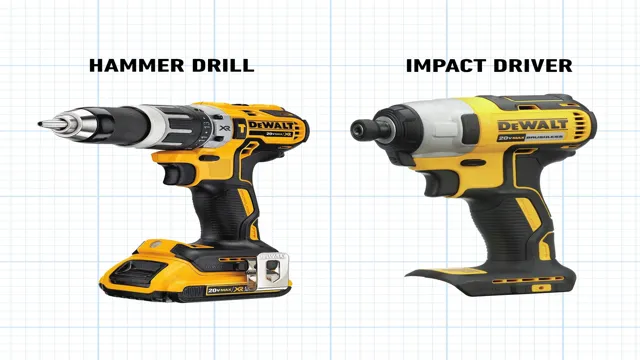
Impact Driver
When it comes to power tools, hammer drills and impact drivers are two types that often get lumped together. While they may look similar and share a few common features, they are actually two very different tools that serve different purposes. A hammer drill is designed to drill through tough materials like concrete, brick, and stone.
It uses a hammering action to break through the hard surface, while also rotating to drill through the material. This makes it a great tool for heavy-duty construction and renovation projects. On the other hand, an impact driver is more like a power screwdriver.
It is designed to drive screws and other fasteners quickly and efficiently, which makes it perfect for tasks like building furniture, hanging shelves, or installing cabinetry. So, while these two tools look similar on the surface, they are actually quite different. If you’re tackling a project that requires drilling through tough materials, a hammer drill is the best choice.
But if you need to drive screws quickly and easily, an impact driver is the way to go. By understanding the differences between these two types of power tools, you can choose the one that will best suit your needs and get the job done right.
Can You Use a Hammer Drill as an Impact Driver?
If you’re looking for a tool to help you with DIY projects, you might be wondering if you can use a hammer drill as an impact driver. The short answer is yes, but there are some things to keep in mind. While they might look similar, hammer drills and impact drivers are designed for different tasks.
A hammer drill is designed to drill into hard surfaces like concrete, stone or masonry, while an impact driver is designed to drive screws and bolts into wood or metal. However, in a pinch, you can use a hammer drill as an impact driver. Just make sure to use the setting that turns off the hammer mechanism.
Also, the chuck on a hammer drill might not be compatible with certain types of bits, like hexagonal bits, which are commonly used with impact drivers. So, while you can use a hammer drill as an impact driver, it’s not always the best choice. If you plan on doing a lot of projects that involve driving screws and bolts into wood or metal, it might be worth investing in an impact driver.
Pros of Using a Hammer Drill as an Impact Driver
Hammer Drill as an Impact Driver Are you wondering if it’s possible to use a hammer drill as an impact driver? The answer is yes! In fact, using a hammer drill as an impact driver comes with some pros. Hammer drills have a feature that allows them to drill through tough materials like concrete or masonry. This feature can also help in driving long screws and bolts.
However, when it comes to short screws or bolts, a hammer drill may not be the best option. In such cases, using a hammer drill as an impact driver can come in handy. Hammer drills tend to have more power and torque than impact drivers, which can make it easier to tackle more demanding projects.
Plus, switching back and forth between the hammer drill and impact driver can save you time and the hassle of switching between tools. Overall, if you have a hammer drill, using it as an impact driver is a great idea. Its power and versatility can make it a valuable addition to your tool collection.
Cons of Using a Hammer Drill as an Impact Driver
Hammer Drill as an Impact Driver Have you ever considered using a hammer drill as an impact driver? While it may seem like a clever solution to have a multi-purpose tool, it is not recommended. Hammer drills are designed to drill into tough materials like concrete and masonry by creating a hammering motion. Impact drivers, on the contrary, are meant to provide high torque power to loosen or tighten screws, nuts, and bolts.
Thus, hammer drills do not have the same rotational force as impact drivers. Using a hammer drill as an impact driver may cause damage to the tool and the fastener, leading to stripped screws or broken bits. Additionally, the impact driver has an exceptional feature that prevents the bit from slipping from the screw head, which is not available in a hammer drill.
To summarize, while it may seem practical to use a hammer drill for more than just drilling, it is not a good substitute for an impact driver. It is better to invest time and money in buying a specialized tool that is designed for the task at hand.
Considerations Before Using a Hammer Drill as an Impact Driver
If you’re considering using a hammer drill as an impact driver, there are a few things you should keep in mind. While hammer drills and impact drivers may look similar, they serve different purposes and operate differently. Hammer drills are designed to drill holes through tough materials like concrete by using a hammering action that pulverizes the surface.
Meanwhile, impact drivers are used to drive screws and bolts into wood or other materials by delivering impacts that force the fastener to rotate. While it is technically possible to use a hammer drill as an impact driver, it’s not recommended. Hammer drills may have too much power, making them difficult to control and leading to stripped screws or bolts.
Additionally, the hammering action of the drill may damage the surface where the screw or bolt is being driven. So, it’s best to invest in an impact driver if you need one rather than trying to use a hammer drill as a substitute.
How to Use a Hammer Drill as an Impact Driver
If you have a hammer drill and an impact driver, you may be wondering if you can use the hammer drill as an impact driver. While it is possible, it’s not recommended as the two tools have different functions and purposes. A hammer drill is designed for drilling into hard surfaces, such as concrete, while an impact driver is designed for driving screws and fasteners into softer materials, such as wood.
However, if you do need to use your hammer drill as an impact driver, you can do so by attaching a hex adapter to the drill’s chuck and then using hex-shank bits in the adapter. Keep in mind that this may not be as efficient as using an actual impact driver, and you should take care not to damage the drill or the bits. Ultimately, using the right tool for the job will lead to better results and ensure the longevity of your tools.
Step 1: Choose the Right Hammer Drill
If you’re planning to use your hammer drill as an impact driver, there are some essential things that you need to know. Firstly, you must ensure that you’ve chosen the right hammer drill for the job. Hammer drills come in various sizes and power output, and it’s essential to select one that can handle the torque requirements of an impact driver.
The hammer drill should be able to produce enough rpm and torque to drive screws without any trouble, and it should also have an adjustable clutch that allows you to control the torque output. If you pick the wrong hammer drill, you could damage the motor or burn out the motor brushes, leading to costly repairs. Furthermore, a hammer drill with excessive power could cause injury or damage to the workpiece if you’re not careful.
By choosing the right hammer drill, you can ensure that your impact driver works flawlessly and delivers accurate and repeatable results every time.
Step 2: Choose the Right Bits
When using a hammer drill as an impact driver, choosing the right bits is crucial for success. Impact-rated bits are designed specifically for use with impact drivers, as they can handle the high-torque and rapid impacts produced by the tool. They differ from standard drill bits in that they have a hexagonal shank that fits securely into the chuck of the impact driver, preventing slippage and maximizing torque transfer.
Additionally, they are made from high-quality materials, such as chrome vanadium steel or carbide, that can withstand the stresses of impact driving. Some common types of impact-rated bits include Phillips, flat-head, and hex bits. By selecting the appropriate bits for your project and using them with your hammer drill as an impact driver, you can ensure optimal performance and efficiency.
Step 3: Adjust the Settings
If you’re wondering how to use a hammer drill as an impact driver, adjusting the settings is crucial. While both tools share similar functionalities, they work differently and require unique settings to perform optimally. To use a hammer drill as an impact driver, you want to switch off the hammer drilling mode and set the tool to the driving mode.
This ensures that the tool doesn’t hammer on the surface, which can damage your screws or bolts. If your drill has adjustable torque settings, ensure to set it to the right level based on the fastener’s size and material. By doing this, you’ll prevent under or over-tightening your screws.
Additionally, you’ll want to select the right drill bit that corresponds to the fastener’s size to prevent stripping or damaging it. Using a hammer drill as an impact driver can save you time and energy if done correctly, but you must adjust the settings to ensure optimal performance.
Step 4: Use Proper Technique
When using a hammer drill as an impact driver, it’s essential to use proper technique to get the job done comfortably and efficiently. First, make sure to use the proper drill bit for the material you’re working with. Using the wrong bit can cause the bit to slip, damaging both the material and the bit.
Secondly, hold the drill perpendicular to the surface you are drilling into, applying firm and steady pressure. Remember not to force the drill too hard or apply unnecessary pressure, as doing so may reduce the drill’s lifespan and efficiency. Lastly, ensure that the drill bit stays cool and lubricated by applying a small amount of oil regularly.
By following these simple tips and using proper technique, you can use your hammer drill as an impact driver efficiently and effectively.
Conclusion
In short, it’s like asking if a hammer can be used as a screwdriver. Sure, you may be able to make it work in a pinch, but it won’t be efficient or effective. Each tool serves a specific purpose, and while there may be some overlap, it’s always best to use the right tool for the job.
So, while a hammer drill and an impact driver may look similar, they have different functions and should be used accordingly.”
FAQs
What is the main difference between a hammer drill and an impact driver?
The main difference between a hammer drill and an impact driver is their mechanism of action. A hammer drill uses a rotary motion with a hammering action to drill through hard surfaces, while an impact driver uses a rotational motion with high torque to drive screws and bolts.
Can you use a hammer drill as an impact driver?
While a hammer drill can be used to drive screws, it is not recommended as it can damage the screw head and compromise the overall performance of the tool. Impact drivers are specifically designed for driving screws and bolts.
What type of bits can be used with an impact driver?
Impact drivers are designed to work with hexagonal bits, also known as hex bits. These bits have a six-sided shape that fits snugly into the chuck of the impact driver and provides a secure grip for the screw or bolt.
Is an impact driver more powerful than a drill driver?
Yes, an impact driver is generally more powerful than a drill driver as it delivers higher torque that enables it to drive larger screws and bolts into hard surfaces with ease.
Can an impact driver be used for drilling holes?
While an impact driver can be used for drilling holes, it is not recommended as it does not have the same mechanism of action as a drill driver. A drill driver is specifically designed for drilling holes in a wide variety of materials.
What are the benefits of using an impact driver?
The benefits of using an impact driver include increased power, reduced fatigue, and improved accuracy. Impact drivers provide higher torque that enables them to drive screws and bolts quickly and efficiently, reducing the time and effort required for manual driving. Additionally, impact drivers have minimal kickback, which makes them easier and more comfortable to use over extended periods.
Can you use an impact driver to remove screws?
Yes, an impact driver can also be used to remove screws and bolts. The high torque of the impact driver makes it easier to remove stubborn screws that are stuck or rusted. However, it’s important to use the correct bit and adjust the torque settings accordingly to avoid damaging the surrounding material.

